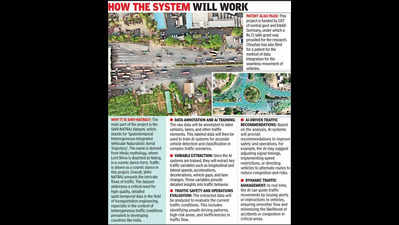
Surat: A PhD research scholar of Sardar Vallabhbhai National Institute of Technology (SVNIT) has developed an artificial intelligence (AI)-based traffic management system to manage traffic effectively. Rajesh Chouhan has prepared a dataset named ‘SHIV-NATRAJ', which contains 6.5 TB of data on different vehicles at traffic junctions, highways, circles, and toll plazas in various cities across the country.
With this data, AI will determine traffic signal timings based on real traffic flow instead of static intervals of 60, 90, or 120 seconds. The dataset will also revolutionise traffic engineering with its observations on traffic and driving behaviour. The ‘SHIV-NATRAJ' dataset was recently launched at SVNIT at an event and is in high demand at institutes worldwide, including in Germany, Australia, the Netherlands, and China.

Chouhan, a student at civil engineering department of SVNIT, worked on this project for the last three years as part of his PhD work. He worked under the supervision of Dr Ashish Dhamaniya, a professor at SVNIT, and Prof Constantinos Antoniou from the Technical University of Munich, Germany. Chouhan said: "We studied traffic patterns in Ahmedabad, Surat, Rajkot, Jaipur, Delhi, Chandigarh, and some parts of Uttarakhand.
With the help of UAVs (drones) and static cameras, we mapped two-wheelers, trucks, auto-rickshaws, and cars. We also collected their movement every 0.2 seconds and stored it in the data.
We have more than 10 crore such data points in our 6.5 TB data recorded." He said dataset ‘SHIV-NATRAJ' will help enable signal timings according to needs.
The dataset also considers the queue of vehicles, road size, road length, and how long the signal should be open. This will save unnecessary time at static signals. For example, if the signal is set for 60 seconds and there are no vehicles, it will automatically go red and shift to the other side.
Similarly, if any side has more vehicles, it will increase the timing there. Chouhan added: "We collected 10 different types of datasets, including vehicle type, speed, lateral speed and acceleration, longitudinal speed and acceleration, lateral gap, and longitudinal gap of vehicles. Based on these values, AI will identify the problem area and fix it immediately.
This is a dynamic dataset as we will keep adding more data and datasets to it so that AI will become more efficient over time at the junction or point it is being used." Dhamaniya believes that UAV-based technology will revolutionise traffic management. "This dataset can be made only in India as we have such a mixed traffic trajectory that very few countries have.
The cutting-edge AI and UAV-based technologies can revolutionise traffic management by addressing congestion, safety, and operational challenges in real-time." He said this would foster the Smart City mission to have a better traffic management plan. By fostering data-driven innovations, it not only enhances efficiency but also lays the foundation for sustainable urban mobility solutions.
"Continuous advancements in such approaches are imperative to meet the growing demands of future transportation systems," he said. Chouhan claims that this is the largest dataset of mixed traffic trajectory in the world. "We sought permissions from various authorities to fly our four UAVs to record the data.
We also aim to solve issues at toll plazas and highways to avoid traffic congestion." BOX Head: Why it is SHIV-NATRAJ? The main part of the project is the SHIV-NATRAJ dataset , which stands for ‘Spatiotemporal Heterogeneous Integrated Vehicular Naturalistic Aerial Trajectory'. The name is derived from Hindu mythology, where Lord Shiva is depicted as Natraj, in a cosmic dance form.
Traffic is shown as a cosmic dance in this project. Overall, SHIV-NATRAJ unravels the intricate flows of traffic. The dataset addresses a critical need for high-quality, detailed spatiotemporal data in the field of transportation engineering, especially in the context of heterogeneous traffic conditions prevalent in developing countries like India.
Head: Patent Also Filed This project is funded by DST of central govt and DAAD-Germany, under which a Rs 21 lakh grant was provided for the research. Chouhan has also filed for a patent for the method of data integration for the seamless movement of vehicles. ‘ Head: How the system will work Data Annotation and AI Training: The raw data will be annotated to label vehicles, lanes, and other traffic elements.
This labelled data will then be used to train AI systems for accurate vehicle detection and classification in complex traffic scenarios Variable Extraction: Once the AI systems are trained, they will extract key traffic variables such as longitudinal and lateral speeds, accelerations, decelerations, vehicle gaps, and lane changes. These variables provide detailed insights into traffic behaviour Traffic Safety and Operations Evaluation: The extracted data will be analyzed to evaluate the current traffic conditions. This includes identifying unsafe driving patterns, high-risk areas, and inefficiencies in traffic flow AI-Driven Traffic Recommendations: Based on the analysis, AI systems will provide recommendations to improve safety and operations.
For example, the AI may suggest adjusting signal timings, implementing speed restrictions, or directing vehicles to alternate routes to reduce congestion and risks Dynamic Traffic Management: In real time, the AI can guide traffic movements by issuing alerts or instructions to vehicles, ensuring smoother flow and minimizing the likelihood of accidents or congestion in critical areas.














